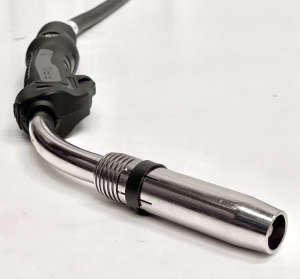What is your welding torch power?
Learn how to choose the correct torch power.
When choosing a welding torch for our equipment, one of the most important factors is the power of the gun, or what is the same, the maximum intensity of use that it can endure.
Most manufacturers use the maximum intensity of use as a reference when selecting the right torch, but this reference should be understood only as that, a reference. The intensity in real circumstances will be notably lower for the following reasons.
- The intensity reference is always taken with 100% CO2 protection gas: this gas has more cooling power than the Argon mixture, but the reality is that CO2 is not often used for intensities above 150A.
- With protection gas mixture of Ar + 15-20% CO2, the capacity is reduced by approximately 20% due to the lower cooling capacity. This type of gas mix is more common for most welding applications, therefore this reference is closer to the real usage.
- In addition, with long arc welding (spray arc) or its controlled process, pulsed arc, the capacity is reduced by approximately 30% due to the greater contribution of radiation heat on the spare part.
In most cases, a long arc weld (spray arc) occurs when the intensity exceeds the limits as shown on the box below. Limit variations depend mainly on the type of gas and the diameter of the welding wire:
Example limits for carbon steel ER70S-3.
- Level above 200A for 1.0 mm wire with Ar + 15% CO2
- Level above 240A for 1.2 mm wire with Ar + 15% CO2
We can conclude that in intensity processes above those levels, the capacity will be reduced by 30% due the type of long arc.
With this data we reach the following conclusion: For a gun model with capacity for 500A according to the manufacturer’s reference, the actual capacity that we must estimate for the gun will be:
Gun of 500 A minus 20% for using mixed gas = 400 A, at 400 A with mixing, 30% is reduced per type of long arc (spray or pulsed arc) = 280 A.
WORK CYCLES
On the other hand, we have the work cycles, being the most usual of 60% for gas-cooled systems and 100% for liquid-cooled systems, these cycles are tested in periods of 10 min according to the normative standards, which means that on a given cycle, 60% indicates that the torch welds 6 minutes out of the 10 minutes the cycle lasts.
These cycle values are important when our application has to make welding beads longer than 10 min, although the calculated value above fits with our application, we will have to think of choosing a torch with a superior power because of the exceeding time cycle, preferably with a system of nozzle cooling where the spare part will have an optimal duration.
In conclusion, we can see that the real intensity is close to half of what is indicated in the technical data sheet by most manufacturers. Therefore, when choosing a welding torch power, our real reference value is almost half, that is if we want the spare parts to have a good performance.
Jose Carlos Moreno/Translated by Maicol Umana.
Share this article!
Contact the author for more info!

